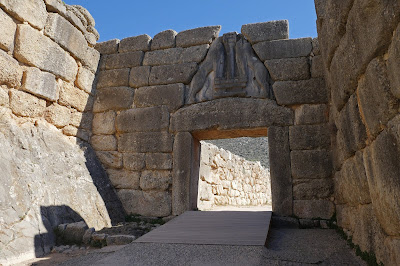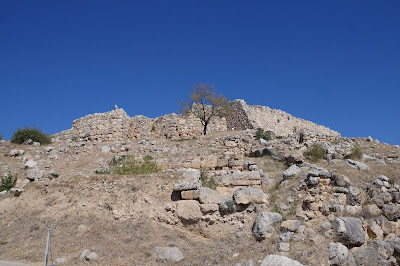First view of Mycenae
The next stop on our tour of the Peloponnese is the ancient city of Mycenae, whose king according to myth was Agamemnon. His brother Menelaus was married to Helen of Troy and her elopement with Paris/Alexander (also of Troy) sparked the Trojan War. Agamemnon's wife was Clytemnestra (who I have only just discovered was Helen's sister – I thought I had got the Trojan war clear in my head, but evidently not). The war ended badly for Troy and also for Agamemnon, who on his return to Mycenae was murdered by Clytemnestra and her lover Aegisthus. This was in revenge for Agamemnon's sacrifice to the gods of his daughter Iphigenia in order to get sufficient wind for the Greek fleet to sail. It's a great story, but it seems to have little to do with the reality of Mycenae since the city dates from about 1500 BC and most authorities date the Trojan war (if there was one) to about 300 years later.
We had our first glimpse of the ancient city as we drove up the hill towards the car park (see above). You can make out an outer wall, a citadel above it and and large mountain in the background.
When we arrived the dominant impression was of the massive "Cyclopian" walls – so thick that it was believed that they could only have been built by Cyclopses.
We headed towards the main gate, the famous Lion Gate. A narrow passage, rather like a barbican in a medieval castle, leads to the gate itself, with the celebrated twin lions looking down over the lintel.
When we arrived the dominant impression was of the massive "Cyclopian" walls – so thick that it was believed that they could only have been built by Cyclopses.
We headed towards the main gate, the famous Lion Gate. A narrow passage, rather like a barbican in a medieval castle, leads to the gate itself, with the celebrated twin lions looking down over the lintel.
This was the view looking back once we were inside.
We passed Grave Circle A, where the German archaeologist Heinrich Schliemann (discoverer of the location of ancient Troy) found a gold face mask during his excavations. "I have gazed upon the face of Agamemnon" he said, although as previously noted what he found is probably older. We then began the uphill climb to the citadel.
Looking back a steady flow of people could be seen plodding up in their turn.
We made our way back down and then went to see the fantastic Tholos. It is a type of burial chamber dating back to the 15th century BC. It consists of three parts: an entrance path (or dromos), an entrance and a tall beehive-shaped chamber. In this case the roof had long disappeared. Other tholoi (I am pretty sure that is the plural - "O" level Greek comes in useful at last!) on the site purport implausibly to be the tombs of Clytemnestra and Aegisthus.
I did have the good fortune to spot a Freyer's Graying just nearby - another new sighting.
Now we headed a short way back down the hill to see the Treasury of Atreus (father of Agamemnon). This is actually another tholos, so it was not a Treasury and most likely had nothing to do with Atreus. It is however a magnificent structure.
Now we headed a short way back down the hill to see the Treasury of Atreus (father of Agamemnon). This is actually another tholos, so it was not a Treasury and most likely had nothing to do with Atreus. It is however a magnificent structure.
The entrance dromos is 35m long, the two lintels over the entrance weigh120 tons and the dome is 13m high and has a a diameter of 14.5m. For over a 1,000 years it was the largest domed structure in the world.
Now on towards our next stop at Nafplio via the Mycenean site at Tiryns – it is bracketed together with Mycenae as a single World Heritage Site so I am going to cover both in a single post. Tiryns is set in much lower countryside and, as with Mycenae, you are struck by the massive walls (best seen from the road from Nafplio).
The entrance is round the back and you first walk along a wide path between two vast stone walls.
At the end is passageway inside the outer wall. It is very dramatic, but its purpose does not seem to be known.
You climb up onto the top of the Acropolis where excavations seem to be continuing. There are the by now usual hard-to-understand stumps of walls. The route now leads down and outside the walls through a small opening.
Apart from the fascinating buildings, Tiryns was also awash with butterflies: Swallowtail, Greek Clouded Yellow (see below), a lone Plain Tiger (I hadn't realised this species was to be seen in Greece), Eastern Bath White (also below), Painted Lady, unidentified Blues ... A lovely bonus.
Conditions: hot and sunny.
Rating: five stars.
Rating: five stars.
















No comments:
Post a Comment